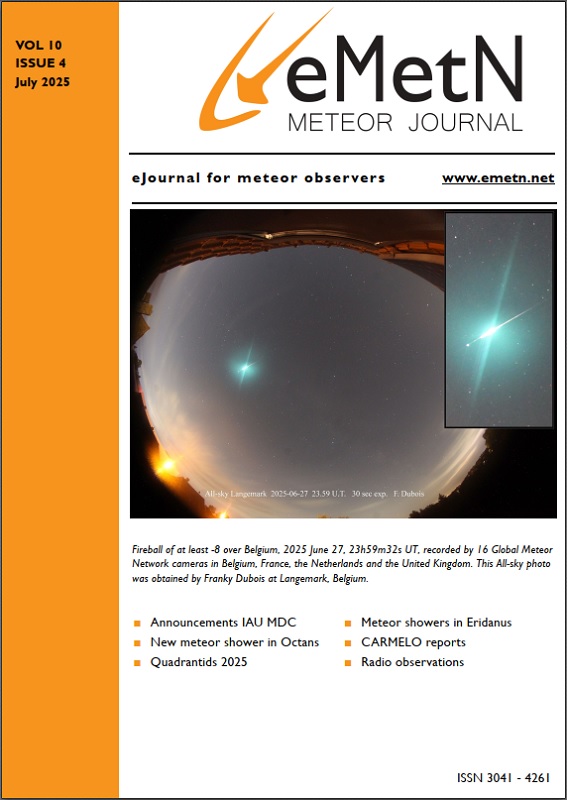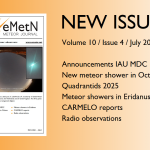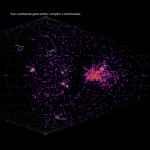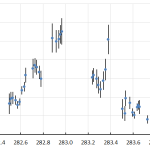Carl Johannink
A summary of the activity of the CAMS BeNeLux network during the month of October 2022 is presented. This month we collected a total of 32170 multi-station meteors resulting in 9749 orbits.
Introduction
Sporadic meteor activity is now nearly reaching its highest level, but there are also several meteor streams visible, reaching their high activity towards the end of this month, like the Orionids and the Taurids.
Meanwhile we can observe for more than 12 hours at our latitudes (50°–53° north). This makes this month one of the most attractive months to observe meteors, therefore, we were curious to see the results.
October 2022 statistics
October 2022 showed a very stable weather pattern. The BeNeLux had many complete clear, or at least partly clear nights. As a result, we could collect a substantial number of orbits in every night this month, except for October 13–14. Skies remained mostly cloudy in our regions. Only 63 meteors were captured by all cameras this night, but none of them was simultaneous from at least two different sites.
A total of 32170 meteors were detected this month, resulting in a record amount of 9749 orbits, see Figure 1. In several nights, October 2–3, 6–7, 8-9, 18–19, 21–22, 23–24, 26–27 and 27–28 the number of orbits was more than 500. The highest number of orbits was collected during October 23–24 with 814 orbits in this single night.
It was striking to see that more than 56% of all orbits were captured by at least 3 cameras during this month. This is an indication that the sky over the BeNeLux is well covered by our network.
For the first time, we could receive results from a station in Luxembourg. Philippe Schaack is running an RMS camera LU0001 (CAMS 3952) from Roodt-sur-Syre since October 19.
On average 86.4 cameras were active at 31 stations in the BeNeLux during this month. At least 68 cameras (October 14–15) and a maximum of 94 cameras (October 8–9 and 9–10) were active. These numbers are slightly better than last month (Figure 1 and Table 1).
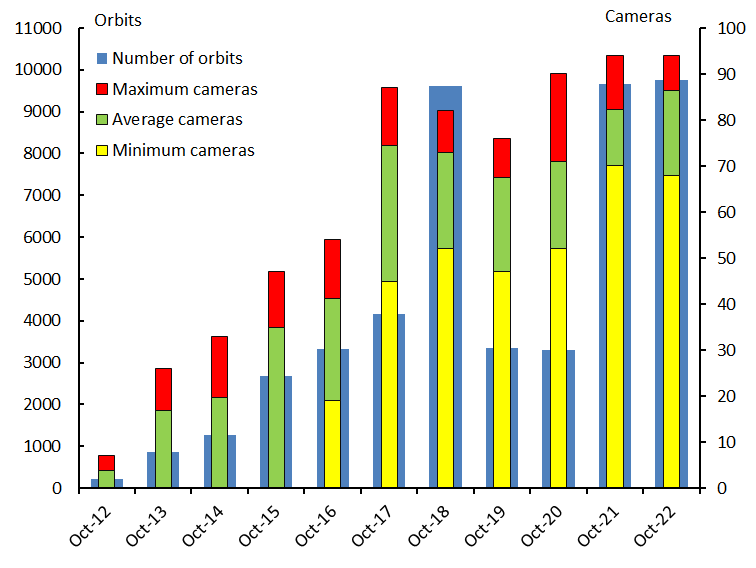
Figure 1 – Comparing October 2022 to previous months of October in the CAMS BeNeLux history. The blue bars represent the number of orbits, the red bars the maximum number of cameras capturing in a single night, the green bar the average number of cameras capturing per night and the yellow bar the minimum number.
Table 1 – Number of orbits and active cameras in the BeNeLux during October 2012–2022.
|
Year |
Nights |
Orbits |
Stations |
Max. Cams |
Min. Cams |
Mean Cams |
|
2012 |
16 |
220 |
6 |
7 |
– |
3.9 |
|
2013 |
20 |
866 |
10 |
26 |
– |
16.8 |
|
2014 |
22 |
1262 |
14 |
33 |
– |
19.7 |
|
2015 |
24 |
2684 |
15 |
47 |
– |
34.8 |
|
2016 |
30 |
3335 |
19 |
54 |
19 |
41.3 |
|
2017 |
29 |
4163 |
22 |
87 |
45 |
74.4 |
|
2018 |
29 |
9611 |
21 |
82 |
52 |
73.0 |
|
2019 |
29 |
3344 |
20 |
76 |
47 |
67.5 |
|
2020 |
29 |
3305 |
23 |
90 |
52 |
70.9 |
|
2021 |
29 |
9669 |
26 |
94 |
70 |
82.2 |
|
2022 |
30 |
9749 |
31 |
94 |
68 |
86.4 |
|
Total |
287 |
48208 |
|
|
|
|
Focus on a minor shower
In the past, around October 5 there have been sometimes reports about a substantial meteor activity from the Draconid/Camelopardalid region (Jenniskens, 2005; 2006). Based on the high activity in October 2005 this minor shower was listed as an ‘established shower’ in the IAU as October Camelopardalids, OCT#281 (Jenniskens 2005).
In 2018 higher activity of this meteoroid stream was mentioned again at this date (Roggemans et al., 2019). However, from CAMS data it is clear that we can see meteors from this minor shower in every year.
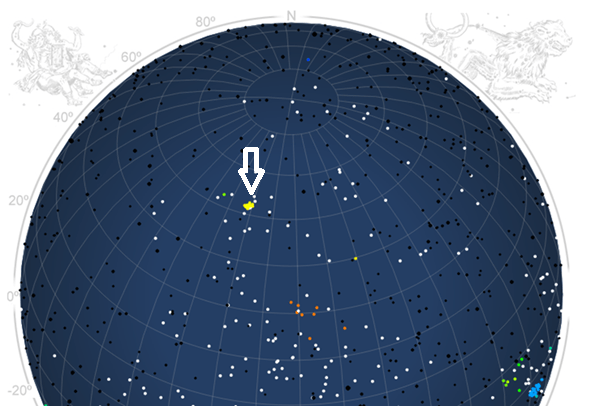
Figure 2 – Radiant plot for CAMS BeNeLux data on 2022 October 5–6.
Table 2 – Number of OCT#281 meteors during 2022 October 5–6 (data CAMS BeNeLux).
|
UT |
λʘ (°) |
OCT |
Comment |
|
20h54m |
192.2892 |
– |
First orbit |
|
23h07m–23h36m |
192.38–192.40 |
1 |
|
|
23h36m–00h06m |
192.40–192.42 |
0 |
|
|
00h06m–00h35m |
192.42–192.44 |
0 |
|
|
00h35m–01h04m |
192.44–192.46 |
0 |
|
|
01h04m-01h33m |
192.46–192.48 |
0 |
|
|
01h33m–02h02m |
192.48–192.50 |
0 |
|
|
02h02m–02h31m |
192.50–192.52 |
1 |
|
|
02h31m–03h00m |
192.52–192.54 |
3 |
|
|
03h00m–03h30m |
192.54–192.56 |
0 |
|
|
03h30m–03h59m |
192.56–192.58 |
2 |
|
|
03h59m–04h28m |
192.58–192.60 |
3 |
|
|
04h28m–04h58m |
192.60-192.62 |
3 |
|
|
04h58m |
192.6207 |
– |
Last orbit |
Figure 2 shows a nice compact radiant near RA = 165° and Decl. = +78° (yellow dots) on 2022 October 5–6 (data CAMS BeNeLux). The first OCT meteor was captured at 23h22m59s UT by Bart Dessoy (Zoersel, Belgium), Steve Rau (Zillebeke, Belgium), Steve Rau (Oostende, Belgium) and Adriana and Paul Roggemans (Mechelen, Belgium). The last OCT meteor that night was captured at 04h46m24s UT by Luc Gobin (Mechelen, Belgium), Hervé Lamy (Ukkel, Belgium) and Pierre-Yves Péchart (Hagnicourt, France).
In Table 2 we see the number of OCT-meteors during this night in intervals of 30 minutes. Triggered by good observing conditions, visual observers Michel Vandeputte and Koen Miskotte decided to make observations this night. They also looked whether they could detect visually activity from this shower. They made the following comments: “The most striking aspect of these meteors is their medium speed. Visual observers, who are not aware of activity of this shower, will certainly classify these meteors as sporadic”.
It is interesting to look whether the display of the activity, visible in the CAMS data (Table 2), is also visible in the data of Michel and Koen. Their results are as follows:
MISKO
- 02h09m–03h10m UT 1 OCT +3
- 03h10m–04h20m UT 3 OCT +2 ; +3 ; +4
VANMC
- 01h30m–02h30m UT 1 OCT +3
- 02h30m–03h30m UT 2 OCT +3, +2
- 03h30m–04h30m UT 2 OCT +3, +2
From this data we can say that for these visual observers the activity is more or less in agreement with CAMS data.
This is a nice confirmation that an attentive observer, who is aware of activity of a minor stream, can monitor this stream also.
Conclusion
The results for October 2022 are the best in 11 years of the CAMS BeNeLux network for this month.
Acknowledgment
In October 2022 the CAMS BeNeLux network was operated by the following volunteers:
Hans Betlem (Woold, Netherlands, CAMS 3071, 3072 and 3073), Jean-Marie Biets (Wilderen, Belgium, CAMS 379, 380, 381 and 382), Ludger Boergerding (Holdorf, Germany, RMS 3801), Günther Boerjan (Assenede, Belgium, RMS 3823), Martin Breukers (Hengelo, Netherlands, CAMS 320, 321, 322, 323, 324, 325, 326 and 327, RMS 319, 328 and 329), Seppe Canonaco (Genk, RMS 3818 and 3819), Pierre de Ponthiere (Lesve, Belgium, RMS 3816 and 3826), Bart Dessoy (Zoersel, Belgium, CAMS 397, 398, 804, 805, 806, 3888 and RMS 3827), Tammo Jan Dijkema (Dwingeloo, Netherlands, RMS 3199), Isabelle Ansseau, Jean-Paul Dumoulin, Dominique Guiot and Christian Walin (Grapfontaine, Belgium, CAMS 814 and 815, RMS 3814 and 3817), Uwe Glässner (Langenfeld, Germany, RMS 3800), Luc Gobin (Mechelen, Belgium, CAMS 3890, 3891, 3892 and 3893), Tioga Gulon (Nancy, France, CAMS 3900 and 3901), Robert Haas (Alphen aan de Rijn, Netherlands, CAMS 3160, 3161, 3162, 3163, 3164, 3165, 3166 and 3167), Robert Haas (Texel, Netherlands, CAMS 810, 811, 812 and 813), Kees Habraken (Kattendijke, Netherlands, RMS 3780 and 3781), Klaas Jobse (Oostkapelle, Netherlands, CAMS 3030, 3031, 3032, 3033, 3034, 3035, 3036 and 3037), Carl Johannink (Gronau, Germany, CAMS 3100, 3101, 3102), Reinhard Kühn (Flatzby, Germany, RMS 3802), Hervé Lamy (Dourbes, Belgium, CAMS 394 and 395, RMS 3825), Hervé Lamy (Humain, Belgium, RMS 3821), Hervé Lamy (Ukkel, Belgium, CAMS 393), Koen Miskotte (Ermelo, Netherlands, CAMS 3051, 3052, 353 and 354), Pierre-Yves Péchart (Hagnicourt, France, RMS 3902 and 3903), Tim Polfliet (Gent, Belgium, CAMS 396, RMS 3820), Steve Rau (Oostende, Belgium, RMS 3822), Steve Rau (Zillebeke, Belgium, CAMS 3850 and 3852, RMS 3851 and 3853), Paul and Adriana Roggemans (Mechelen, Belgium, RMS 3830 and 3831, CAMS 3832, 3833, 3834, 3835, 3836 and 3837), Jim Rowe (Eastbourne, Great Britain, RMS 3829), Philippe Schaack (Roodt-sur-Syre, Luxemburg, RMS 3952), Hans Schremmer (Niederkruechten, Germany, CAMS 803), Erwin van Ballegoij (Heesh, Netherlands CAMS 3148 and 3149).
References
Jenniskens P., Moilanen J., Lyytinen E., Yrjölä I. and Brower J. (2005). “The 2005 October 5 outburst of October Camelopardalids”. WGN, Journal of the International Meteor Organization, 33, 125–128.
Jenniskens P. (2006). Meteor Showers and their Parent Comets. ISBN 0521853494. Cambridge, UK: Cambridge University Press. Pages 528–530.
Jenniskens P., Gural P. S., Grigsby B., Dynneson L., Koop M. and Holman D. (2011). “CAMS: Cameras for Allsky Meteor Surveillance to validate minor meteor showers”. Icarus, 216, 40–61.
Roggemans P., Johannink C., Cambell-Burns P. (2019). “October Camelopardalids (OCT#281)”. eMetN, 4, 65–73.

